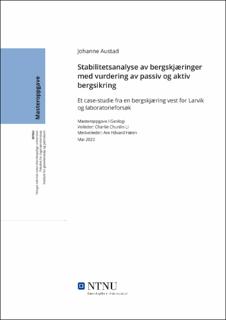| dc.description.abstract | Ved etablering av bergskjæringer vil analyse og vurdering av stabilitet være nødvendig for å opprettholde sikkerheten langs veien. For at resultatene fra stabilitetsberegningene skal være pålitelige er det avgjørende med pålitelige inngangsparametre. Gjennom arbeidet med denne masteroppgaven ble det gjennomgått ulike beregnings- og analysemetoder for vurdering av stabilitet. Det ble lagt mest vekt på statisk likevektsanalyse, og ved utførelse av en parameteranalyse ble de ulike faktorene som inngår i likevektsberegning vurdert opp mot hverandre. Parameterene ble tildelt partialfaktorer i henhold til Eurokode 7, som er dagens standard for geoteknisk prosjektering i Europa. Resultatene fra analysen viste at skjærstyrkeparameterne hadde størst påvirkning på sikkerhetsfaktoren, og variering av kohesjons og friksjonsvinkel kunne gi store utslag på stabiliteten. Både Mohr-Coulomb og Barton-Bandis bruddkriterium for skjærstyrke ble undersøkt i parameteranalysen.
Forskjæringen til Paulertunnelen langs E18 vest for Larvik ble brukt som et case-studie i oppgaven. Feltmålinger av blant annet sprekkeorientering og sprekkeruhet ble brukt for å utføre en stabilitetsanalyse av en 30 meter høy kile. Gjennom analysen ble stabiliteten vurdert ved ulike vanntrykk, og det ble gjort beregninger på hvor mye sikring som ville kreves for de ulike situasjonene. Stabiliteten til kilen ble både vurdert i henhold til dagens krav, ved bruk av partialfaktorer, i tillegg til den tradisjonelle metoden ved bruk av sikkerhetsfaktor. Resultatene fra begge metodene ble sammenlignet, og viste at kilen ville kreve mer sikring ved bruk av den tradisjonelle metoden med sikkerhetsfaktor, enn når partialfaktorer ble benyttet i beregningene. Resultatene fra analysen og nødvendig sikring ble også sammenlignet med en ingeniørgeologisk rapport.
Gjennom arbeidet med masteroppgaven ble forskjellen mellom passiv og aktiv bergsikring undersøkt. I et laboratorieforsøk på betongblokker ble boltekapasitet og bruddforløp for forspente og uforspente bolter testet. Betongblokkene ble sagd i to for å lage et svakhetsplan. For noen av prøvene ble de sagde flatene påført epoxy-lim som skulle simulere kohesjon langs svakhetsplanet. Prøvene ble påført en vertikal last fra bergpressen i laboratoriet, og ble plassert på en rulleplate for at lastfordelingen i størst mulig grad skulle tilsvare en reel skråning eller skjæring. Hovedfunnene fra testingen tilsa at prøvene med forspente bolter kunne ta opp mer last før brudd enn prøvene med uforspente bolter. Dette gjaldt både prøvene med og uten kohesjon langs svakhetsplanet. I tillegg viste resultatene at prøvene med uforspente bolter gjennomgikk mer deformasjon før boltene begynte å bære last enn prøvene med forspente bolter. | |
| dc.description.abstract | When establishing rock cuts, analysis and assessment of the stability will be necessary to maintain safety along the road. To achieve reliable results from the stability calculations, reliable input parameters are crucial. Through the work of this master's thesis, various calculation and analysis methods for assessing stability were reviewed. Emphasis was placed on static equilibrium analysis. A parameter analysis was carried out to consider the various factors included in the equilibrium calculation. The parameters were assigned partial factors in accordance with Eurocode 7, which is the current standard for geotechnical engineering in Europe. The results from the analysis indicated that the shear strength parameters had the greatest influence on the safety factor, and that variation in cohesion and friction angle could have a major effect on the stability. Both the Mohr-Coulomb and Barton-Bandis shear strength criteria were studied in the analysis.
A rock cut next to the Pauler tunnel along E18 west of Larvik was used as a case study in the thesis. Field measurements, including joint orientation and joint roughness, were used to perform a stability analysis of a 30 meter high wedge. Through the analysis, the stability was assessed at different joint water pressures, and the amount of rock reinforcement were evaluated. The stability of the wedge was assessed in accordance with current requirements, using partial factors, in addition to the traditional, deterministic safety factor method. The results from both methods were compared, and indicated that the wedge would require more reinforcement using the traditional safety factor method, than when partial factors were included in the calculations. The results from the analysis and necessary reinforcement were also compared with an engineering geology report.
Through the work of the master's thesis, the difference between passive and active rock reinforcement was investigated. Through a laboratory test on concrete blocks, bolt capacity and bolt performance of pretensioned and untensioned bolts were tested. The concrete blocks were cut in half to make a failure plane. For some of the samples, epoxy glue was applied to simulate cohesion along the failure plane. The samples were exposed to a vertical load from the rock press in the laboratory, and were placed on a rolling plate to make sure the load distribution would correspond to a real slope or cut as much as possible. The main findings from the testing indicated that the samples with pretensioned bolts could withstand more vertical load before fracture than the samples with untensioned bolts. This applied to both the samples with and without cohesion along the failure plane. In addition, the results indicated that the samples with untensioned bolts were subjected to more deformation before the bolts started to carry load, than the samples with pretensioned bolts. | |
